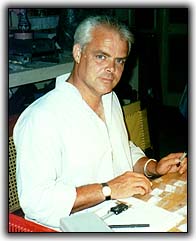

Richard H. Meadow Jonathan Mark Kenoyer
The Sites
Archaeological Digs
Archaeologists have been finding many exciting things in the Indus valley. Most
of the discoveries are dated back to the ancient Indus Valley Civilization.
The archaeologists have been finding many things about the ancient
civilization. As they dug they found out how organized the people were. They
had advanced sewerage systems and excellent housing plans. They built roads
and walkways that look like modern day streets. Archaeologists also found writing
on stones that had carvings of animals and markings. The archaeologists are
unable to describe the writing that was on the stones. As the archaeologists
dug deeper they found civilizations piled on top of civilizations. Each one
was organized and planned out well.
Jonathan M. Kenoyer and Richard H. Meadow are great leaders of the research
of the Ancient Indus Valley Civilization. Dr.Kenoyer is an anthropologist who
is a professor from the University of Wisconsin. He is co-directing the research
project in Harrapa. The other man Richard H. Meadow is a zooarchaeology at Peabody
museum. He graduated from Harvard. He was the project director for the Harrapa
research project.


Richard H. Meadow Jonathan Mark Kenoyer
Stupas
Just when Siddharta Gautama (Buddha) founded Buddhism, many people had moved to the west. Some of those people ended up in the ares of Mohenjo-daro. The famous stupa in Mohenjo-daro was made by those people. The stupa in Mohenjodaro was made from sun-dried bricks adn was the first building archaeologists found of this Indus Valley Civilization. It is encircled with monastic, or monastery like cells on all four sides of the stupa and was placed on a high platform, according to the Buddhist religion. It was the highest surviving mound in Mohenjo-daro, and it was made and long time after the known period of the Indus Valley Civilization. Inside are remains of an earlier period of the civilization. The stupa has helped archaeologists unearth the culture of the civilizations beneath it. The stupa gave the archaeologists a first look at the Mohenjo-daro civilization.

Model of Stupa
Preservation of Sites
The remains of structures at Moenjodaro were in a good state of preservation when they were unearthed. The bricks were so hot that it seemed like they were baked in red. After the weather changed a white salt was noticed on the bricks. This caused their collapse. Archaeologists experimented with different solutions but they couldn't find a solution. Finally, the Pakistani Government in partnership with UNESCO solved the problem. They made a masterplan. This plan included ground water control, river training schemes, conservation of structural remains, and protection and landscaping of sites. Thes things made sure that the threat of water logging, erosion, and salinity could be prevented in a scientific manner.
Mohenjodaro, Larkana  District,
Sindh, Pakistan
District,
Sindh, Pakistan